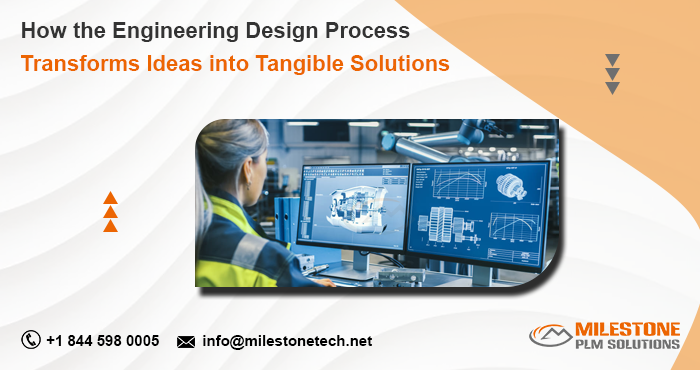How the Engineering Design Process Transforms Ideas into Tangible Solutions
Contents |
[edit] Introduction
The realm of engineering is a dynamic and ever-evolving landscape where innovation and problem-solving go hand in hand. At the heart of this process lies the Engineering Design Process, a systematic approach that converts abstract ideas into tangible solutions. In this article, we will explore the key stages of the Engineering Design Process and how it plays a pivotal role in shaping the world around us.

[edit] Understanding the Engineering Design Process
The Engineering Design Process is a series of steps that engineers follow to conceive, develop, and implement solutions to real-world problems. While the specific stages may vary, a typical process involves:
- Problem Definition: Identifying and understanding the problem at hand is the first crucial step. Engineers delve deep into the challenges, constraints, and requirements to formulate a clear problem statement.
- Research and Gathering Information: Informed decision-making is vital in engineering. Engineers conduct extensive research to gather data, explore existing solutions, and understand the technological landscape related to the problem.
- Conceptualisation and Ideation: This stage involves brainstorming and generating a variety of potential solutions. Creativity takes centrr stage as engineers explore different concepts and ideas to address the identified problem.
- Preliminary Design: Once a set of promising concepts is identified, engineers move on to the preliminary design phase. This involves sketching, prototyping, and creating initial models to visualise and assess the feasibility of each solution.
- Detailed Design: With a refined set of concepts, engineers delve into the nitty-gritty details of the chosen solution. This stage involves creating detailed plans, specifications, and blueprints that guide the actual implementation.
- Prototyping and Testing: Building prototypes allows engineers to validate their designs in a real-world setting. Testing helps identify potential flaws, refine the design further, and ensure the final solution meets the specified requirements.
- Optimisation: Continuous improvement is a key aspect of engineering. Engineers analyse test results, gather feedback, and optimise the design to enhance performance, efficiency, and overall effectiveness.
- Final Implementation: The refined design is now ready for full-scale implementation. This stage involves the construction, assembly, or deployment of the final product or solution.
[edit] The Role of Technology and AI in the Engineering Design Process
As technology advances, so does its impact on the Engineering Design Process. Artificial Intelligence (AI) tools have become integral in streamlining various stages of the process. Here's how:
- Data Analysis and Simulation:
AI algorithms can quickly analyse vast amounts of data, aiding engineers in making informed decisions. Simulation tools powered by AI enable realistic testing scenarios, helping refine designs before physical prototypes are built.
- Generative Design:
AI-driven generative design tools explore countless design possibilities based on specified parameters. This not only accelerates the conceptualisation phase but also unveils innovative solutions that human designers might not have considered.
- Predictive Maintenance:
In the detailed design and implementation stages, AI plays a role in predictive maintenance. By analysing data from sensors and monitoring systems, AI can predict potential issues, enabling proactive maintenance and minimising downtime.
[edit] Conclusion
The Engineering Design Process is a dynamic journey that transforms abstract ideas into tangible solutions. With technology and AI tools becoming increasingly integrated into this process, engineers can navigate the complexities of design, testing, and implementation more efficiently. As we embrace these advancements, the future holds exciting possibilities for engineering solutions that push the boundaries of innovation.
The MILESTONE team can assist you with Product Design, 3d Modelling, Drafting & detailing, Reverse Engineering, FEA Analysis and more. We support multiple software including AutoCAD, Solidworks, Catia, NX, Inventor, Solidedge & Ansys etc. Our approach is to provide a dedicated team for each customer over ongoing project and deliver the quality output consistently
--Engineering Design & BIM Services
[edit] Related articles on Designing Buildings
- Asset information model.
- Benefits of manufacturer-created BIM models.
- BIM dimensions.
- BIM dimensions, maturity and levels of development.
- BIM execution plan.
- BIM for dummies - an interview.
- BIM levels of development (LOD).
- Centrally procured public projects.
- Construction Operations Building Information Exchange (COBie).
- CIC BIM Protocol.
- Common data environment.
- Data drops.
- Federated building information model.
- Government Construction Strategy.
- Industry Foundation Classes.
- Information manager.
- Level 2 BIM.
- Level 3 BIM.
- Level of detail.
- Open data.
- PAS 1192-2:2013.
- PAS 1192-3:2014.
- Project information model.
- The 4 Stages of BIM Process in Construction.
- Uniclass.
Featured articles and news
Editor's broadbrush view on forms of electrical heating in context.
The pace of heating change; BSRIA market intelligence
Electric Dreams, Boiler Realities.
New President of ECA announced
Ruth Devine MBE becomes the 112th President of the Electrical Contractors Association.
New CIAT Professional Standards Competency Framework
Supercedes the 2019 Professional Standards Framework from 1 May 2025.
Difficult Sites: Architecture Against the Odds
Free exhibition at the RIBA Architecture Gallery until 31 May.
PPN 021: Payment Spot Checks in Public Sub-Contracts
Published following consultation and influence from ECA.
Designing Buildings reaches 20,000 articles
We take a look back at some of the stranger contributions.
Lessons learned from other industries.
The Buildings of the Malting Industry. Book review.
Conserving places with climate resilience in mind.
Combating burnout.
The 5 elements of seiri, seiton, seiso, seiketsu and shitsuke.
Shading for housing, a design guide
A look back at embedding a new culture of shading.
The Architectural Technology Awards
The AT Awards 2025 are open for entries!
ECA Blueprint for Electrification
The 'mosaic of interconnected challenges' and how to deliver the UK’s Transition to Clean Power.
Grenfell Tower Principal Contractor Award notice
Tower repair and maintenance contractor announced as demolition contractor.























